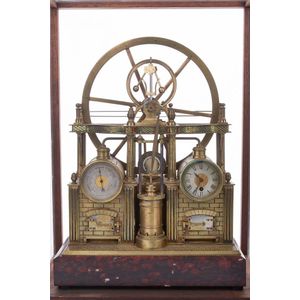French Industrial Automaton Clock, 19th Century, with Presentation Case
French novelty automaton industrial clock, late 19th century, modelled as an industrial steam engine, with large automaton fly wheel and piston, driven by a large barrel housed in the base, the front ornamented with mock brickwork and furnaces, with silvered dials housed in drums with a clock, an aneroid barometer and a Reaumur thermometer, on rouge marble base, in presentation case, movement (A/F), height 59 cm width 44 cm depth 29 cm (in case). Provenance: Private Collection, Sydney, reference: Cf. For comparison Derek Roberts mystery, novelty and Fantasy clocks, Schiffer 1999, p.265, Fig.22-27, and the collection of the Science Museum of Victoria
You must be a subscriber, and be logged in to view price and dealer details.
Subscribe Now to view actual auction price for this item
When you subscribe, you have the option of setting the currency in which to display prices to $Au, $US, $NZ or Stg.
This item has been sold, and the description, image and price are for reference purposes only.
- Movement - The technical name for the workings of a clock or watch, and does not include the dial or case.
- A/f, as Inspected - The letters "A/F" or "as inspected" as part of a description is the cataloguer's shorthand for "all faults" or "as found", meaning the item has some type of damage or deficiency, it is of uncertain date or provenance, and/or that the seller takes no responsibility for the completeness of the item or the accuracy of the description.
- Barrel (in a Clock) - In a clock or watch, the barrel is a cylindrical component that stores the energy from the mainspring. As the mainspring is wound, it stores energy in the barrel. As the clock or watch runs, the energy is gradually released from the barrel, turning the clock's gears and keeping the time.
The barrel is typically located near the centre of the movement (the mechanism that powers the clock) and is connected to the center wheel, which drives the rest of the gears. The barrel typically has teeth on its outer surface that mesh with the gears in the movement, allowing it to transmit energy to the rest of the clock. Some barrels are designed to be wound by hand, while others are automatically wound by the motion of the wearer's arm.
This item has been included into following indexes:
- clocks, material or decoration - industrial style 30
-
clocks, type
- automata / automaton 45
- novelty 59
- steam hammer 4
